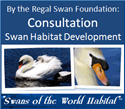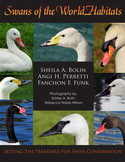Ask the Swan Specialist
Date: 8 October 2012
Hi Christine:
Absolutely, yes, swans can have major leg or feet problems especially young swans. If the cygnets are placed on any slippery, wet or unstable surface such as newspapers, plastic or cardboard, they can sustain splayed legs. If they are improperly handled, the legs can become splayed. If splayed or spraddled legs are the diagnosis, the avian veterinarian will need to tape the leg so that the young tendons grow normally. This may or may not work, but it is the best solution as we have seen very poor results from tendon surgery.
If the cygnets are allowed to climb steep banks, they can sustain splayed legs or sprains and strains which are not only painful, but may keep the birds from wanting or able to use the legs/feet. All water features should have a zero entrance and the substrate should be hay, straw, dirt or grass to prevent slipping. Additionally, hard abrasive surfaces such as asphalt, concrete or rocky surfaces can cause a condition known as "bumblefoot" which can not only be painful, but can become so infected that a large abscessed callous forms and the birds cannot walk without major veterinary intervention.
Neurological problems such as fungal, parasitic, viral or bacterial infections can affect swans' legs and prevent their normal usage due to temporary or permanent paralysis or weakness. Lack of vitamin A, found in yellow grain such as cracked corn can also induce neurological problems with legs that prevent their normal use due to weakness. Ensure that the cygnets are eating poultry layer pellets, cracked corn and lettuce submerged in water as the main food source. Vitamin B-12 can be adminstered by the veterinarian to induce appetite. Lack of appetite, not eating or pooping normally can be a sign that the swan is going down hill. Prompt veterinary care is of the utmost importance.
If any waterfowl cannot enter or exit water to bathe, preen, escape predators, feed or do other natural behaviors requring wet or dry habitat areas, the prognosis is not good. If the cygnet survives with some water rehabilitation to strengthen the legs once a diagnosis has been made, it should do well. However, if the leg is not usuable, it may be relegated to a captive setting where there is a zero entrance to and from a water feature so that it can butt scoot in and out of the water. Some people may deem this as cruel and the bird euthanized if it cannot live in a natural setting. However, we have first hand experience with birds being placed in zero entrance captive settings that lived a life in which they found a mate an raised cygnets of their own. Good luck and please let us know the diagnosis.
Messages In This Thread
- Cignet with bad leg -- christine -- 8 October 2012
- Re: Cignet with bad leg -- The Regal Swan -- 8 October 2012
- Re: Cignet with bad leg -- christine -- 8 October 2012
- Re: Cignet with bad leg -- The Regal Swan -- 9 October 2012
- Re: Cignet with bad leg -- christine -- 9 October 2012
- Re: Cignet with bad leg -- The Regal Swan -- 9 October 2012
- Re: Cignet with bad leg -- christine -- 9 October 2012
- Re: Cignet with bad leg -- The Regal Swan -- 9 October 2012
- Re: Cignet with bad leg -- christine -- 8 October 2012
- Re: Cignet with bad leg -- The Regal Swan -- 8 October 2012
Ask the Swan Specialist is powered by
Tetra-WebBBS 5.30 Beta © 2006-2007 Tetra-Team






